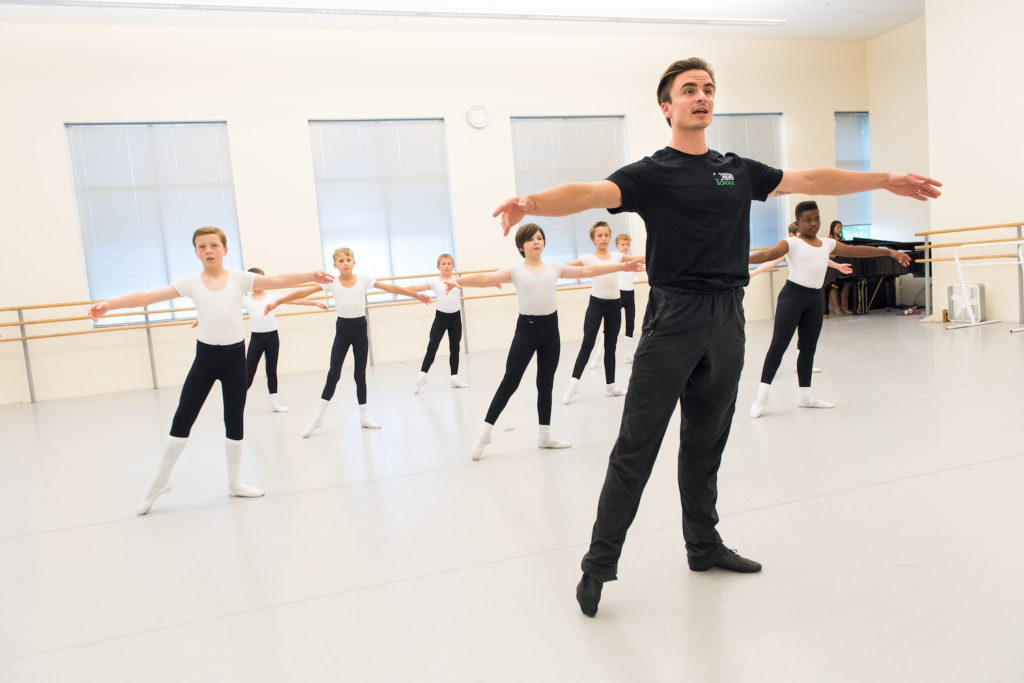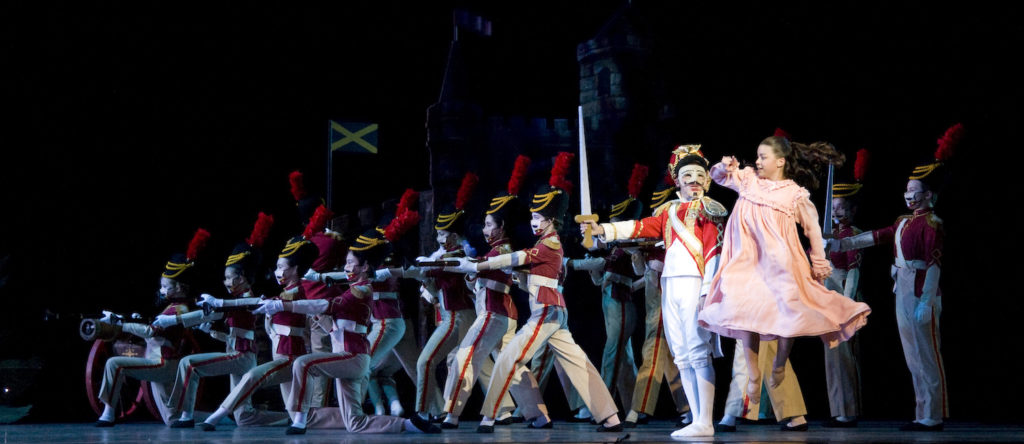We asked our friends at Oregon Ballet Theatre School to share what makes men’s programs in ballet so special. Read on to learn more from Interim Artistic Director Peter Franc, teacher Elise Legere, and Soloist and teacher Gustavo Ribeiro.

Oregon Ballet Theatre School is the official training ground of Oregon Ballet Theatre, and is dedicated to the development and support of boys in ballet. Students receive exemplary training from a world-class faculty, emphasizing pure classical technique. The students’ experience is enhanced by invaluable opportunities to perform in fully staged productions at the Keller Auditorium alongside OBT company members.
The Boys’ Program at OBT School includes classes that focus on gender specific skills and strengthening for young male students. Parents of current students state “they are gaining musicality and confidence and connection to their bodies. We also appreciate the structure, discipline, and dedication to hard work they are learning at OBT. It is wonderful for them to come to the dance studio and see the older boy students and male company members … it gives them male role models who are strong and talented and shows them where dance can take them if they work hard.”
Interested in boys’ ballet classes, but want to know what to expect? We caught up with OBT Interim Artistic Director Peter Franc, OBT School veteran teacher Elise Legere, and OBT Soloist/School teacher Gustavo Ribeiro, who each share their approach to teaching, the benefits of boys’ classes and training elements that lead to success.
Since you have been involved in the boys’/men’s program at OBT School and elsewhere, what have you experienced teaching an all-male ballet class?
Peter: The sense of camaraderie is probably the most unique and important thing for the boys. The feeling of belonging … helps them feel like they aren’t alone.
Elise: I have noticed a boy’s approach to class to be less intimidating. There are always fewer students in an all-male class, instilling less peer pressure. This atmosphere lets them be more enthusiastic and more confident.
Do you notice any difference in the way males participate in an all-male ballet class versus a co-ed class?
Peter: That usually depends on what environment the teacher creates. I like to keep it moving a little faster and challenge the boys with more jump combinations than we might do in a co-ed setting.
Gustavo: The differences are in the classes. When it’s a co-ed class the steps are mostly focused on the general technique, applied in both male and female work. Young male dancers tend to get distracted easily and rely on the female dancers to pick up the combination. In my classes, I make sure they all know the steps, so they can all work properly and develop a strong technique.

Do you have a special way of approaching the teaching and curriculum content of male students?
Peter: I find that demonstrating the steps with a fuller energy helps get them more excited to try things than if I just verbally explain what I want.
Gustavo: Discipline, resilience and understanding are the most important things that I take into consideration for my classes. With that being said, I don’t move on with my classes until the students have accomplished the quality and understanding of each exercise.
Elise: My approach has always been to concentrate on clean, strong technique for male as well as female students. Jumps are given at a slower tempo to develop the strength of the jump, which is expected to be higher and more athletic.
What particular elements do you emphasize when teaching an all-male class?
Peter: Fondues and grande battements are particularly important for men’s technique as that helps develop the foundational strength and power required for the big jumps they are required to do.
Gustavo: Always quality first, then strength, presence and power.
Elise: Stamina is essential. A male dancer adds more beats and height in his jumps and must execute multiple turns in a very wide variety of pirouettes.
Are there unique elements that you feel should be incorporated in a boys’/men’s class?
Peter: Upper body strength for boys is as important as their ballet technique. When I have the time I like to have the boys do push-ups, but they should be doing that on their own time as well!
Gustavo: What I focus on in all my classes is the understanding and awareness of each step. Ballet is like math, so if the students master the basics, they will succeed solving an equation, in other words, complex steps.
Elise: Upper body strength is critical to a male dancer’s training. The male student will be expected to participate in partnering classes where he must support and lift a female dancer. Cross training is part of their schedule. The teacher occasionally gives time between barre and center work for push-ups and planks.
Do you feel it is beneficial to offer all-male classes and why?
Peter: Absolutely! You need to be able to take the time to work on specific things unique to each group. A collective experience helps push everyone involved and supporting your fellow dancers is a very important part of our culture.
Gustavo: The basics are equal to both male and female dancers, but in a boys’ class, male students have an opportunity to build and learn the different approaches and strength that each step requires for multiple turns and higher leaps.
Elise: Personally, the all-male class is very important for strength and technique. I also feel that time with only males in class allows them to build a bond with their fellow students. This bond promotes a healthy competitiveness that builds confidence and pleasure in knowing that hard work brings rewarding results.

- May 2024 Digital Issue - April 23, 2024
- Tween/Teen Summer Camps & Jobs - April 22, 2024
- Featured Camp of the Week: Classical Ballet Academy - April 22, 2024



